PaulT
AH elite
Asiatic Buffalo Hunting in Northern Australia
The Asiatic, or water, buffalo of the tropical regions of Northern Australia is a large bodied, thick-skinned bovine very similar in size and tenacity to its African cousin, the Cape buffalo.
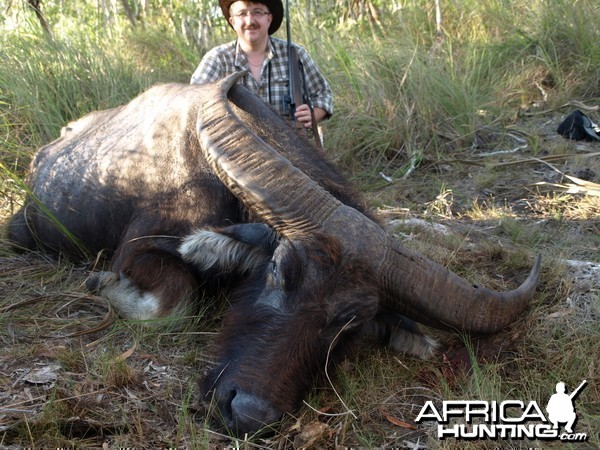
Beautiful bull with very heavy bases and a tint of albino-ism through the horn structure. Taken by a Polish hunter on the second day of his hunt in a very remote area this bull showed signs of extreme advanced age. A spectacular Trophy.
A mature aged bull in prime condition is capable of attaining a body weight approaching 900 kilograms (2,000 pounds) and despite this size can show an amazing turn of speed, especially over short distances. With skin 1 ½ inch (3,81 centimeters) thick on the back of the neck, thick, heavy-set muscular composition and a solid bone structure, the Asiatic Buffalo proves to be a very sturdy test for large caliber firearms and controlled expansion projectiles, and when pursued with respect for ethical hunting methods they can be a challenging, rewarding and exciting hunting experience.
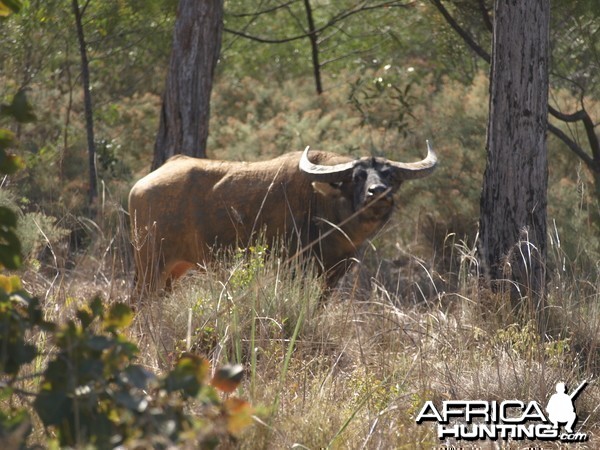
Wallowing in Red dust.
In the past, Buffalo in Australia have been shot, and taken very satisfactorily, with an array of cartridges from the .308 win upwards. In these instances, were the primary concern was removal and reduction of numbers, when shot by pet-meaters, eradicators, government employees and rural staff, the animals were typically shot from the safety of a 4x4 vehicle with little consequence or concern for the results. A solid projectile was delivered to the brain-pan at relatively short distance with the result being one hapless, dead buffalo. The various merits of the hunting challenge, of the unfortunate animal, were, for a long time, deemed as inconsequential as the vast majority of exposure to the buffalo was generously provided by the speed and power of a 4x4 vehicle.
Some 30 years after the infamous Brucellosis and Tuberculosis (BTEC) campaign ended, all of this is of little relevance to the traveling trophy hunter keen on mixing it with the big bulls of the tropics, and experiencing a legitimate big game hunt, undertaken within legitimate hunting ethics.
Buffalo numbers and quality have returned to many parts of the “Top-End” and many hunters from all parts of the globe are beginning to realize the great value in hunting “Aussie” buff, particularly when compared in cost to similar hunts in Africa for the Cape Buffalo.
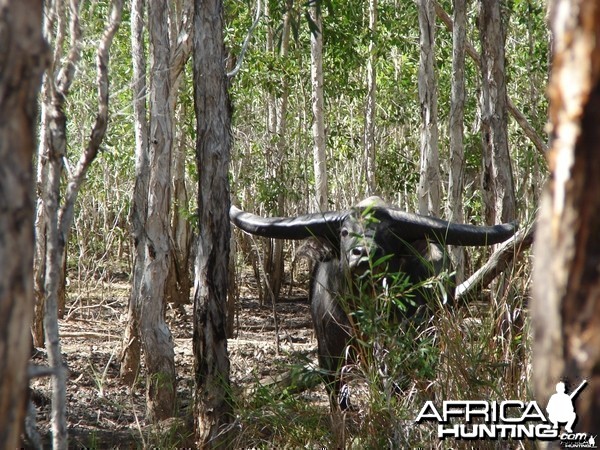
Tremendous wide-spread Asiatic buffalo bull at close quarters in typical thick scrub, this bull would easily score in excess of 100 inches (2.54 meters).
Typically, there are three different hunt experiences available to those wishing to sample the excitement, the reward, and the potential hazard involved with hunting these buffalo.
Within easy reach of the Capital city of the Northern Territory, Darwin, on sealed roads, where stores and supplies for camps are economically procured, thereby providing a less expensive option, are several estate hunts where buffalo, and in some cases a selection of other South Pacific game animals, are contained in extensive fenced areas offering secured results in limited time frames providing a service for those on restricted schedules, and for others wanting multiple species hunts.
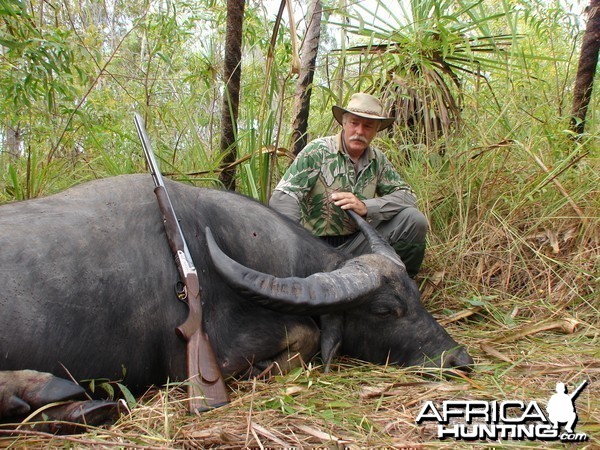
Wonderful bull taken during a very exciting hunt at very close quarters in thick cane grass. This bull put up one heck of a fight, and lost the battle to a .470 & 458 Lott.
The second option available is the station, or cattle ranch, hunt where, in a number of areas sometimes bordering Aboriginal lands, privately owned cattle ranches with populations of migratory and/or resident buffalo offer hunting rights to various safari companies to harvest animals and therefore increase revenue in addition to the existing cattle enterprise. Hunts occurring in this scenario are also generally less expensive than the wilderness deal as most of the cattle stations involved are a good deal closer to amenities and supplies for stores and foodstuffs than wilderness operators. For those not accustomed to the region the station hunt can still provide some sense of wilderness as most of the stations are extensive in area and will, to some extent, exhibit exposure to a lot of the region’s animal and bird-life. Standards of accommodations on station hunts can reasonably be expected to be of a higher standard than wilderness hunt options, though hunters choosing this option must realize that the constant reminders of agricultural enterprise, such as cattle fencing, watering troughs, gates, mustering activities and farm staff are also part and parcel of this hunt.

Big paper-bark forest bull scoring 102 SCI. Taken with a Blaser .470.
The third option available is for the purists, those who want to sample remoteness, pristine wilderness and broad expanses of country where there are NO fences, no stock troughs, no gates or power-lines, few roads and the country is as you would imagine it was hundreds of years ago.
For this experience you need to venture to Arnhemland.
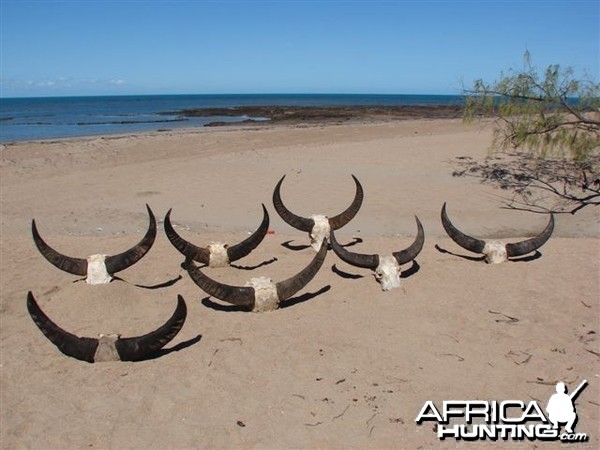
Spoils of the hunt. Photo was set up down on a remote beach for effect. When packing up after this picture was taken a bull was spotted swimming out in the ocean after he had been walking down the beach and was rudely interrupted by our presence and was trying to make his way around us! (see below)
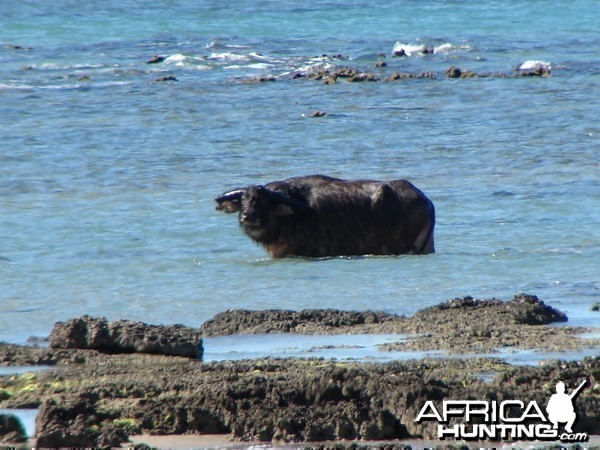
Arnhemland is aboriginal owned land encompassing some 95,000 square kilometers (36,600 square miles) of little disturbed wilderness where the buffalo, and other animals are free to roam and wander where they please. Isolated, remote and difficult to access, the costs involved with this hunt are generally higher than the previously mentioned options as operators are forced to transport stores, supplies and fuels from great distances and supply services in one of the most remote regions remaining on the continent of Australia. Being a wilderness option results cannot be assured, but most operators structure their hunts for a duration where they reasonably know that all being equal, and some straight shooting results, the clients will have multiple shot opportunities over the course of the standard hunt offering.
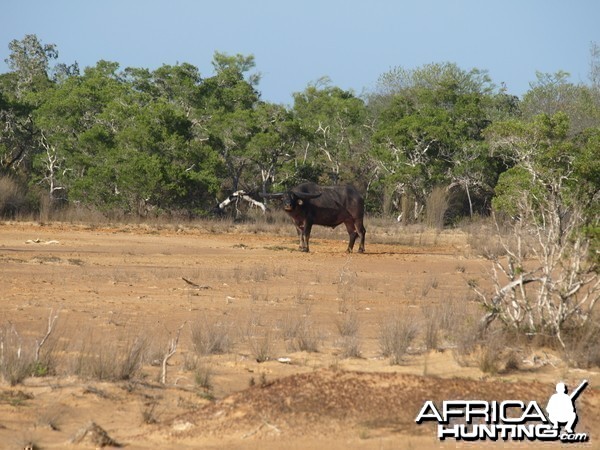
An uncommon open-country shot on a beautiful bull.
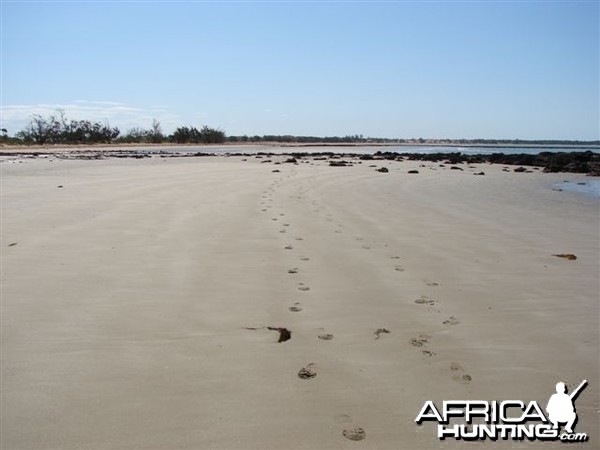
Remote beach of Arnhemland, Australia
As an operator who is based in Arnhemland I will contain my reference to hunting in this area.

Arnhemland scenery and wildlife.
Our company operates a concession spanning in excess of 4,000 square kilometers (1,550 square miles) 2 of pristine wilderness country where there is no domestic stock, no cattle fences, no agriculture and very little other signs of modern development. Interspersed with permanent rivers, swamps, billabongs, seasonal creeks and coastal habitat the terrain can vary from day to day dependent on location.
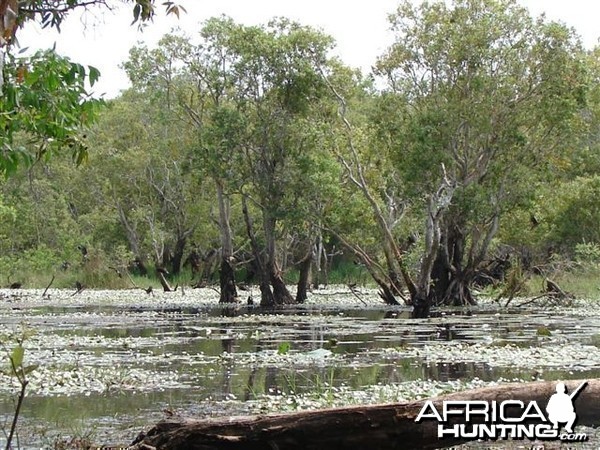
Scenery Arnhemland, Australia
Typically, the hunting terrain in our area is medium-thick scrub and accorded to our preferred hunting methods, all hunting is done on foot and normally shots taken are in some sort of cover at close quarters. Early season hunting ( June to August ) sees the average for shot distances being about 50yds, which may stretch out to 100yds or so later in the season. Early season hunts are perfect for those double rifle hunters, bow hunters or for those that specifically want extreme close quarters contact, the essence of hunting big game. Mid to late season hunts ( August to October ) are prime time for targeting the very biggest of bulls as the country starts to dry out and remote, temporary water sources evaporate, forcing remote area living bulls to travel further for their requirements therefore increasing our incidence of contact with them.
Hunters can reasonably expect to be targeting bulls in the 95 to 100 SCI mark, with some bulls taken exceeding the 100 inches (2.54 meters) mark, and some not. Irrespective of size, a mature bull taken at close range, on foot with your favorite big game rifle is a trophy and experience you’ll not soon forget.
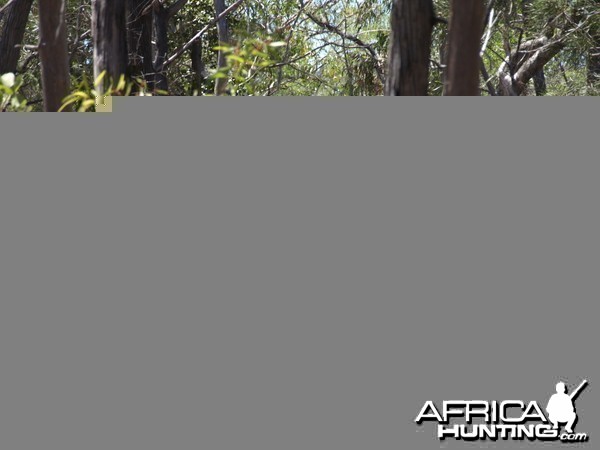
Typical hunting situation on our concession. 70 yards (70 meters) shot in medium-heavy cover. Large caliber firearms are required to put this animal down without it running too far.
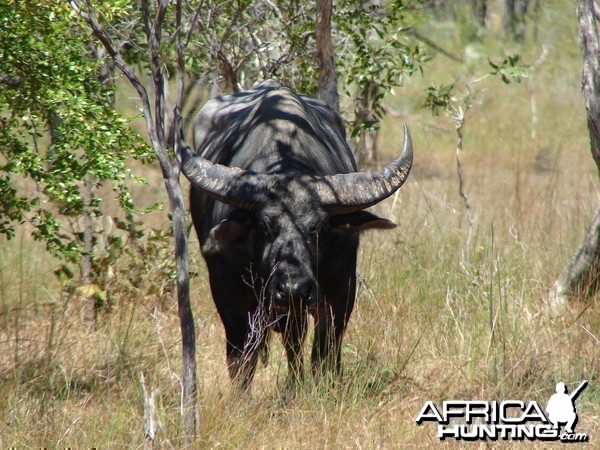
A young bull tests his strength on a sapling.
In these types of hunting situations, specifically referenced to the concession we hunt, we enforce a minimum caliber of .375 H&H with 300gn projectiles in order to ensure recovery of the trophy and a humane dispatch. I must note here that there is no legal minimum requirement enforced by the government, this is a self-imposed clause implemented with consideration for the successful outcome for the hunter and with consideration for the animal’s welfare.
A hunt in the wilderness of Arnhemland will also give you an insight to a tremendous array of native and seasonal bird-life, opportunities to land the infamous barramundi fish and perhaps a sight of some saltwater crocodiles that inhabit the region.
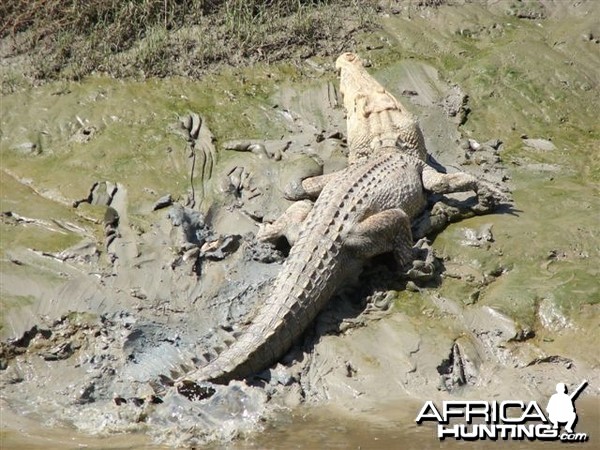
Crocodile Arnhemland, Australia
Typical hunting routine involves departing camp at dawn after a leisurely breakfast and traveling by 4x4 to a predetermined location where you will proceed to hunt on foot. The terrain is typically flat, on hard ground where the difficulty factor is mild. Dependent on location, and due to an inherent lack of vehicle access hunters can expect to have to walk reasonable distances in order to reach areas that are expected to produce results. The level of exertion can be tailored to individual’s requirements to a point, but the greater the limitation placed on ground covered during your hunt may also effect the standards of expectations in terms of trophy size achieved. It would be fair to estimate that on an average morning hunt a gentle walking pace covering anything from 3 to 6 kilometers (1.86 to 3.73 miles) would be required, sometimes less, sometimes more. It is not uncommon for trophy bulls to be seen from the vehicle whilst traveling through the country, and an unexpected opportunity is presented which requires little output in terms of energy expended. In these situations we prohibit shooting bulls from the vehicle, again another limitation that is not legislated by our Government, one we enforce as a company with respect to ethical hunting guidelines. In this instance the hunter present will be provided the option of taking the trophy after the vehicle has been removed to a suitable distance away from the original contact, and a foot hunt to re-contact that animal will begin.
By 10:30 to 11:30 am each morning, as the day begins to heat, winds will begin to eddy and shift direction becoming less predictable. This makes continued hunting a low percentage activity, as most animals will now be bedded down ruminating and resting and vigilant to potential threats. At this time of day we recommend a return to camp to recoup, rest and lunch, or if in an area far from camp we will have meals and refreshments available for a break of a few hours. Apart from the occasion of bulls sometimes visiting a waterhole for a mud-bath or a wallow the middle of the day is generally downtime from hunting and the buffaloes lowest level of activity.
Hunting will recommence again in the middle of the afternoon where traveling to a new area will create more opportunities.
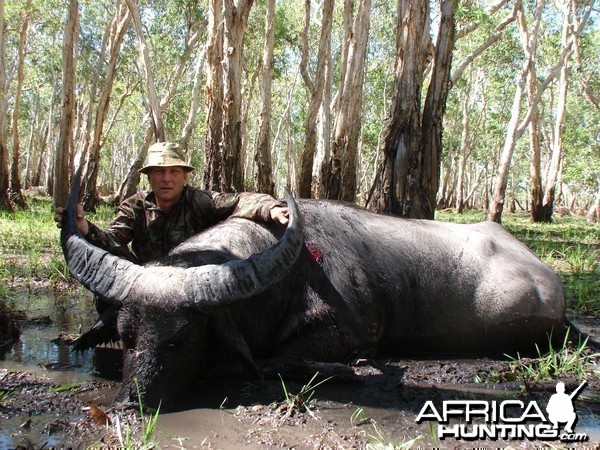
Big water buffalo bull that made it into the swamps after 2 hits from a .470 and one from a 458 Lott.
Our own standard hunts for both one on one and 2x1 hunt durations have been structured accorded to the numbers of buffalo we see during the course of the respective periods and our conviction accorded to the knowledge of our hunting concession that durations of these hunts will provide hunters of reasonable fitness and acceptable firearms skills at least several opportunities over the structured hunt durations to take a respectable, representative or better trophy bull. Results in a free-range wilderness scenario cannot be guaranteed, but then it would be fair to suggest that most operators achieve a standard of results exceeding 90% success rates on representative bulls or better.
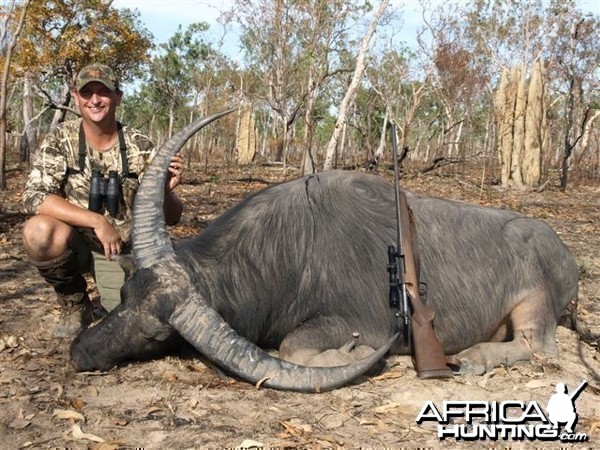
Record class buffalo bull.
Potential buffalo hunters need to consider these issues when planning their hunts. Hunters wishing to take multiple bulls should plan extended hunts for extra days to ensure success. Hunters who have expectations of record class or better trophies need to accept that size of trophies can not be contrived, and for the best opportunity at the biggest bulls there is no substitute for having the appropriate length of time to do so. Heed the advise of your operator, he knows his area the best. Also, hunters need to accept that unknown and unexpected factors such as unseasonable/unexpected weather, shifts in wind patterns and other factors can have undue effect beyond the operators expectations, and your own.
On an average hunt in normal conditions in good country you can expect to see as little as 30 to 50 buffalo per day and as many as 100, or more, on a good day. The percentage of these animals that may be representative trophies, or better, may range from as little as 1 to 3 bulls or as high as 6 to 8. For hunters wishing better odds or stronger assurances you may be better served hunting the confines of a preserve scenario.

Nice bull taken by a client on his first visit to Arnhemland. Taken with a .375 with 300gn Barnes T.S.X's.
With the knowledge we have of our area and the average of the experience of previous hunts we try and focus on bulls exhibiting characteristics of age and maturity. On a normal hunt we will begin by targeting bulls showing these characteristics, of age and maturity and bulls that will score 94 inches (2.39 meters), or greater. For a bull to make this score it will need to have a girth dimension of 17 inches (43.18 centimeters) at the bases together with a horn length of at least 30 inches (76.2 centimeters). Unless otherwise instructed by the hunting client we have not taken, nor is there an expectation or need to take bulls under the 90 inches (2.28 meters) mark as, unless a bull has a portion of broken horn or does not meet the prescribed dimensions it will more often than not be a result of what we ( our company ) deem to be an immature animal.
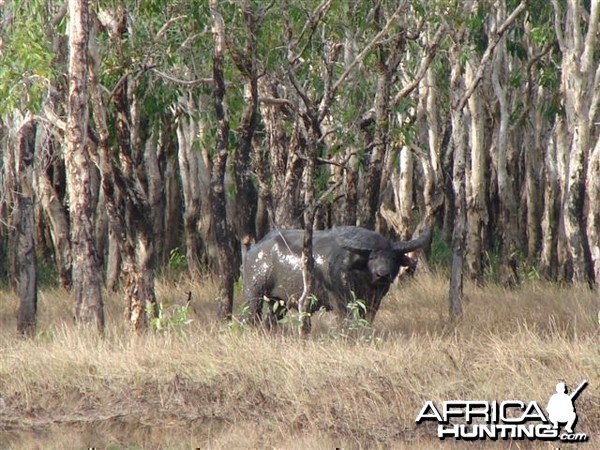
Asiatic buffalo bull, Arnhemland, Australia.
when your buff is in the salt and there is time remaining you may have the option of experiencing the greatly undervalued resource of hunting the tenacious wild Oxen, locally referred to as the Scrub bull or Red-Skin, to you hunt. A species of wild cattle running feral for over a hundred years and acknowledged by SCI as a game animal the Oxen can provide an incredibly taxing and exciting addition to you buffalo hunt.
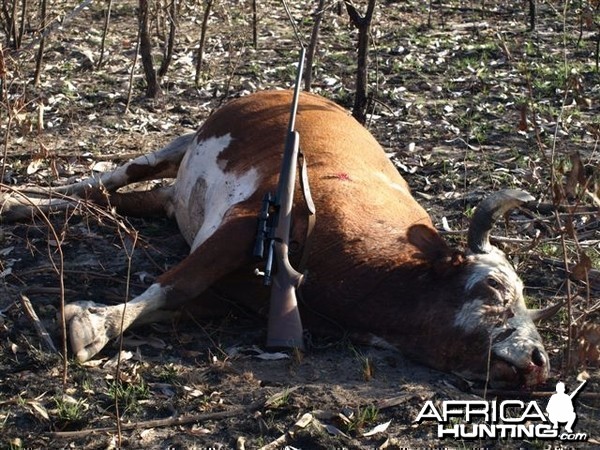
Wild Oxen, Arnhemland, Australia.
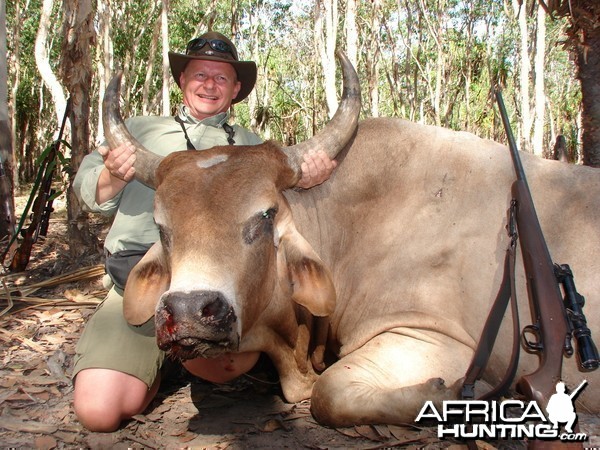
Wild Oxen, Arnhemland, Australia.
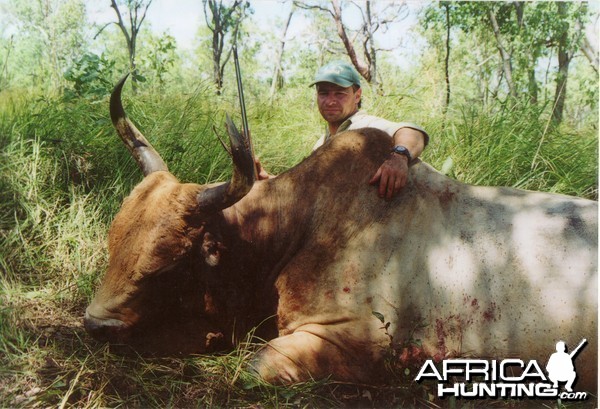
Wild Oxen, Arnhemland, Australia.
Buffalo hunting in the remote Northern reaches of Australia’s tropics can provide hunters with immeasurable pleasure and enjoyment, exciting confrontations and real exposure to a potentially dangerous big game animal in a safe country to travel to, for a fraction of the cost of a similar exercise undertaken in Africa.
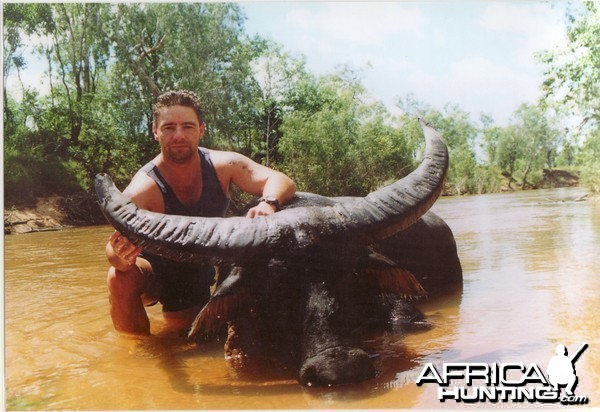
Representative buff taken with .416 Rigby at close quarters. Ended up expiring in the river after a volly of shots.
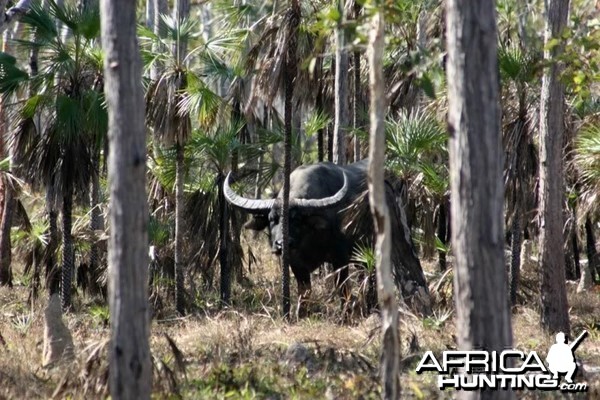
Beautiful bull hiding in a Fan Palm forest.
For the big-game, or big-bore, enthusiast this hunt provides a comparatively inexpensive opportunity for some real fodder for that double gun or big bore you have at home. When combined with the tremendous tourism opportunities available in the Top-End such as Heritage listed Kakadu National Park it’s a heck of an excuse to bring your partner along and experience a piece of the “down-under” land.
So what are you waiting for!
Good health and good hunting to you all.
Paul Truccolo
Paul Truccolo
Southern Safaris Australia
ssahuntinfo@optusnet.com.au
www.southernsafaris.com.au
Here's some live footage showing the terrain and the animals in some real hunting situations, no "set-ups".
The Asiatic, or water, buffalo of the tropical regions of Northern Australia is a large bodied, thick-skinned bovine very similar in size and tenacity to its African cousin, the Cape buffalo.
Beautiful bull with very heavy bases and a tint of albino-ism through the horn structure. Taken by a Polish hunter on the second day of his hunt in a very remote area this bull showed signs of extreme advanced age. A spectacular Trophy.
A mature aged bull in prime condition is capable of attaining a body weight approaching 900 kilograms (2,000 pounds) and despite this size can show an amazing turn of speed, especially over short distances. With skin 1 ½ inch (3,81 centimeters) thick on the back of the neck, thick, heavy-set muscular composition and a solid bone structure, the Asiatic Buffalo proves to be a very sturdy test for large caliber firearms and controlled expansion projectiles, and when pursued with respect for ethical hunting methods they can be a challenging, rewarding and exciting hunting experience.
Wallowing in Red dust.
In the past, Buffalo in Australia have been shot, and taken very satisfactorily, with an array of cartridges from the .308 win upwards. In these instances, were the primary concern was removal and reduction of numbers, when shot by pet-meaters, eradicators, government employees and rural staff, the animals were typically shot from the safety of a 4x4 vehicle with little consequence or concern for the results. A solid projectile was delivered to the brain-pan at relatively short distance with the result being one hapless, dead buffalo. The various merits of the hunting challenge, of the unfortunate animal, were, for a long time, deemed as inconsequential as the vast majority of exposure to the buffalo was generously provided by the speed and power of a 4x4 vehicle.
Some 30 years after the infamous Brucellosis and Tuberculosis (BTEC) campaign ended, all of this is of little relevance to the traveling trophy hunter keen on mixing it with the big bulls of the tropics, and experiencing a legitimate big game hunt, undertaken within legitimate hunting ethics.
Buffalo numbers and quality have returned to many parts of the “Top-End” and many hunters from all parts of the globe are beginning to realize the great value in hunting “Aussie” buff, particularly when compared in cost to similar hunts in Africa for the Cape Buffalo.
Tremendous wide-spread Asiatic buffalo bull at close quarters in typical thick scrub, this bull would easily score in excess of 100 inches (2.54 meters).
Typically, there are three different hunt experiences available to those wishing to sample the excitement, the reward, and the potential hazard involved with hunting these buffalo.
Within easy reach of the Capital city of the Northern Territory, Darwin, on sealed roads, where stores and supplies for camps are economically procured, thereby providing a less expensive option, are several estate hunts where buffalo, and in some cases a selection of other South Pacific game animals, are contained in extensive fenced areas offering secured results in limited time frames providing a service for those on restricted schedules, and for others wanting multiple species hunts.
Wonderful bull taken during a very exciting hunt at very close quarters in thick cane grass. This bull put up one heck of a fight, and lost the battle to a .470 & 458 Lott.
The second option available is the station, or cattle ranch, hunt where, in a number of areas sometimes bordering Aboriginal lands, privately owned cattle ranches with populations of migratory and/or resident buffalo offer hunting rights to various safari companies to harvest animals and therefore increase revenue in addition to the existing cattle enterprise. Hunts occurring in this scenario are also generally less expensive than the wilderness deal as most of the cattle stations involved are a good deal closer to amenities and supplies for stores and foodstuffs than wilderness operators. For those not accustomed to the region the station hunt can still provide some sense of wilderness as most of the stations are extensive in area and will, to some extent, exhibit exposure to a lot of the region’s animal and bird-life. Standards of accommodations on station hunts can reasonably be expected to be of a higher standard than wilderness hunt options, though hunters choosing this option must realize that the constant reminders of agricultural enterprise, such as cattle fencing, watering troughs, gates, mustering activities and farm staff are also part and parcel of this hunt.
Big paper-bark forest bull scoring 102 SCI. Taken with a Blaser .470.
The third option available is for the purists, those who want to sample remoteness, pristine wilderness and broad expanses of country where there are NO fences, no stock troughs, no gates or power-lines, few roads and the country is as you would imagine it was hundreds of years ago.
For this experience you need to venture to Arnhemland.
Spoils of the hunt. Photo was set up down on a remote beach for effect. When packing up after this picture was taken a bull was spotted swimming out in the ocean after he had been walking down the beach and was rudely interrupted by our presence and was trying to make his way around us! (see below)
Arnhemland is aboriginal owned land encompassing some 95,000 square kilometers (36,600 square miles) of little disturbed wilderness where the buffalo, and other animals are free to roam and wander where they please. Isolated, remote and difficult to access, the costs involved with this hunt are generally higher than the previously mentioned options as operators are forced to transport stores, supplies and fuels from great distances and supply services in one of the most remote regions remaining on the continent of Australia. Being a wilderness option results cannot be assured, but most operators structure their hunts for a duration where they reasonably know that all being equal, and some straight shooting results, the clients will have multiple shot opportunities over the course of the standard hunt offering.
An uncommon open-country shot on a beautiful bull.
Remote beach of Arnhemland, Australia
As an operator who is based in Arnhemland I will contain my reference to hunting in this area.
Arnhemland scenery and wildlife.
Our company operates a concession spanning in excess of 4,000 square kilometers (1,550 square miles) 2 of pristine wilderness country where there is no domestic stock, no cattle fences, no agriculture and very little other signs of modern development. Interspersed with permanent rivers, swamps, billabongs, seasonal creeks and coastal habitat the terrain can vary from day to day dependent on location.
Scenery Arnhemland, Australia
Typically, the hunting terrain in our area is medium-thick scrub and accorded to our preferred hunting methods, all hunting is done on foot and normally shots taken are in some sort of cover at close quarters. Early season hunting ( June to August ) sees the average for shot distances being about 50yds, which may stretch out to 100yds or so later in the season. Early season hunts are perfect for those double rifle hunters, bow hunters or for those that specifically want extreme close quarters contact, the essence of hunting big game. Mid to late season hunts ( August to October ) are prime time for targeting the very biggest of bulls as the country starts to dry out and remote, temporary water sources evaporate, forcing remote area living bulls to travel further for their requirements therefore increasing our incidence of contact with them.
Hunters can reasonably expect to be targeting bulls in the 95 to 100 SCI mark, with some bulls taken exceeding the 100 inches (2.54 meters) mark, and some not. Irrespective of size, a mature bull taken at close range, on foot with your favorite big game rifle is a trophy and experience you’ll not soon forget.
Typical hunting situation on our concession. 70 yards (70 meters) shot in medium-heavy cover. Large caliber firearms are required to put this animal down without it running too far.
A young bull tests his strength on a sapling.
In these types of hunting situations, specifically referenced to the concession we hunt, we enforce a minimum caliber of .375 H&H with 300gn projectiles in order to ensure recovery of the trophy and a humane dispatch. I must note here that there is no legal minimum requirement enforced by the government, this is a self-imposed clause implemented with consideration for the successful outcome for the hunter and with consideration for the animal’s welfare.
A hunt in the wilderness of Arnhemland will also give you an insight to a tremendous array of native and seasonal bird-life, opportunities to land the infamous barramundi fish and perhaps a sight of some saltwater crocodiles that inhabit the region.
Crocodile Arnhemland, Australia
Typical hunting routine involves departing camp at dawn after a leisurely breakfast and traveling by 4x4 to a predetermined location where you will proceed to hunt on foot. The terrain is typically flat, on hard ground where the difficulty factor is mild. Dependent on location, and due to an inherent lack of vehicle access hunters can expect to have to walk reasonable distances in order to reach areas that are expected to produce results. The level of exertion can be tailored to individual’s requirements to a point, but the greater the limitation placed on ground covered during your hunt may also effect the standards of expectations in terms of trophy size achieved. It would be fair to estimate that on an average morning hunt a gentle walking pace covering anything from 3 to 6 kilometers (1.86 to 3.73 miles) would be required, sometimes less, sometimes more. It is not uncommon for trophy bulls to be seen from the vehicle whilst traveling through the country, and an unexpected opportunity is presented which requires little output in terms of energy expended. In these situations we prohibit shooting bulls from the vehicle, again another limitation that is not legislated by our Government, one we enforce as a company with respect to ethical hunting guidelines. In this instance the hunter present will be provided the option of taking the trophy after the vehicle has been removed to a suitable distance away from the original contact, and a foot hunt to re-contact that animal will begin.
By 10:30 to 11:30 am each morning, as the day begins to heat, winds will begin to eddy and shift direction becoming less predictable. This makes continued hunting a low percentage activity, as most animals will now be bedded down ruminating and resting and vigilant to potential threats. At this time of day we recommend a return to camp to recoup, rest and lunch, or if in an area far from camp we will have meals and refreshments available for a break of a few hours. Apart from the occasion of bulls sometimes visiting a waterhole for a mud-bath or a wallow the middle of the day is generally downtime from hunting and the buffaloes lowest level of activity.
Hunting will recommence again in the middle of the afternoon where traveling to a new area will create more opportunities.
Big water buffalo bull that made it into the swamps after 2 hits from a .470 and one from a 458 Lott.
Our own standard hunts for both one on one and 2x1 hunt durations have been structured accorded to the numbers of buffalo we see during the course of the respective periods and our conviction accorded to the knowledge of our hunting concession that durations of these hunts will provide hunters of reasonable fitness and acceptable firearms skills at least several opportunities over the structured hunt durations to take a respectable, representative or better trophy bull. Results in a free-range wilderness scenario cannot be guaranteed, but then it would be fair to suggest that most operators achieve a standard of results exceeding 90% success rates on representative bulls or better.
Record class buffalo bull.
Potential buffalo hunters need to consider these issues when planning their hunts. Hunters wishing to take multiple bulls should plan extended hunts for extra days to ensure success. Hunters who have expectations of record class or better trophies need to accept that size of trophies can not be contrived, and for the best opportunity at the biggest bulls there is no substitute for having the appropriate length of time to do so. Heed the advise of your operator, he knows his area the best. Also, hunters need to accept that unknown and unexpected factors such as unseasonable/unexpected weather, shifts in wind patterns and other factors can have undue effect beyond the operators expectations, and your own.
On an average hunt in normal conditions in good country you can expect to see as little as 30 to 50 buffalo per day and as many as 100, or more, on a good day. The percentage of these animals that may be representative trophies, or better, may range from as little as 1 to 3 bulls or as high as 6 to 8. For hunters wishing better odds or stronger assurances you may be better served hunting the confines of a preserve scenario.
Nice bull taken by a client on his first visit to Arnhemland. Taken with a .375 with 300gn Barnes T.S.X's.
With the knowledge we have of our area and the average of the experience of previous hunts we try and focus on bulls exhibiting characteristics of age and maturity. On a normal hunt we will begin by targeting bulls showing these characteristics, of age and maturity and bulls that will score 94 inches (2.39 meters), or greater. For a bull to make this score it will need to have a girth dimension of 17 inches (43.18 centimeters) at the bases together with a horn length of at least 30 inches (76.2 centimeters). Unless otherwise instructed by the hunting client we have not taken, nor is there an expectation or need to take bulls under the 90 inches (2.28 meters) mark as, unless a bull has a portion of broken horn or does not meet the prescribed dimensions it will more often than not be a result of what we ( our company ) deem to be an immature animal.
Asiatic buffalo bull, Arnhemland, Australia.
when your buff is in the salt and there is time remaining you may have the option of experiencing the greatly undervalued resource of hunting the tenacious wild Oxen, locally referred to as the Scrub bull or Red-Skin, to you hunt. A species of wild cattle running feral for over a hundred years and acknowledged by SCI as a game animal the Oxen can provide an incredibly taxing and exciting addition to you buffalo hunt.
Wild Oxen, Arnhemland, Australia.
Wild Oxen, Arnhemland, Australia.
Wild Oxen, Arnhemland, Australia.
Buffalo hunting in the remote Northern reaches of Australia’s tropics can provide hunters with immeasurable pleasure and enjoyment, exciting confrontations and real exposure to a potentially dangerous big game animal in a safe country to travel to, for a fraction of the cost of a similar exercise undertaken in Africa.
Representative buff taken with .416 Rigby at close quarters. Ended up expiring in the river after a volly of shots.
Beautiful bull hiding in a Fan Palm forest.
For the big-game, or big-bore, enthusiast this hunt provides a comparatively inexpensive opportunity for some real fodder for that double gun or big bore you have at home. When combined with the tremendous tourism opportunities available in the Top-End such as Heritage listed Kakadu National Park it’s a heck of an excuse to bring your partner along and experience a piece of the “down-under” land.
So what are you waiting for!
Good health and good hunting to you all.
Paul Truccolo
Paul Truccolo
Southern Safaris Australia
ssahuntinfo@optusnet.com.au
www.southernsafaris.com.au
Here's some live footage showing the terrain and the animals in some real hunting situations, no "set-ups".
Last edited by a moderator:
